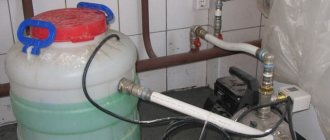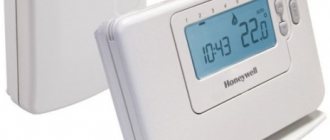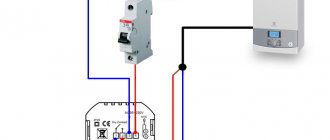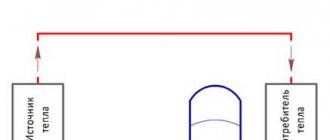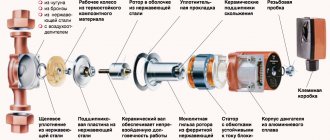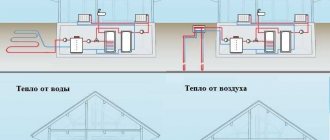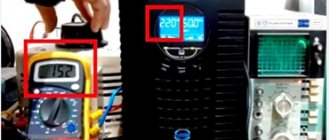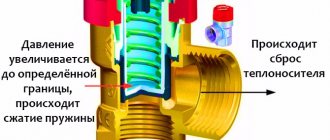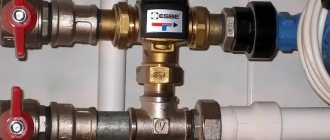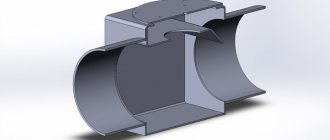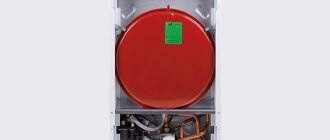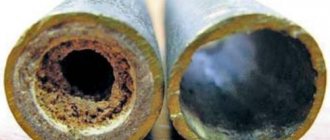How to choose a circulation pump for heating
For the selection of equipment, taking into account the most suitable parameters, it is necessary use certain formulas
... However, only specialists know which formulas should be used in each specific case. And if the device is selected by an unknowing person, then you should use the following recommendations:
- Circulation pump marking
... For example, Grundfos UPS 25-50 equipment, where the first two digits indicate the diameter of the threads of the nuts - 25 millimeters (1 inch), which are supplied with the device. There are also pumps with nut diameters of 32 millimeters (1.25 inches). The second two digits are the maximum rise height of the coolant in the heating system - 5 meters, that is, with the help of a circulation pump, an excess pressure of no more than 0.5 atmospheres can be created. There are also pumps in which the lift heights are 3, 4, 6 and 8 meters. - Unit performance
... It is the main parameter that determines the operation of the unit. Represented by the volume of the coolant pumped by the pump. For the calculation, the formula is applied:
Q = N: (t2-t1), - where N is the power of the heat source. It can be a boiler or a gas water heater;
- t 1 - shows the temperature of the water in the return pipe. As a rule, it is equal to + 65-70 0 С;
- t 2 - shows the temperature of the water that is in the supply pipeline (comes out of the boiler or gas water heater). Often the boiler maintains + 90-95 0 С.
- The calculation of the heating system and its losses is carried out in order to correctly select the design parameters of the unit that is able to cope with the resistance in the heating system.
... Shows the maximum head that the heating system is capable of. This is the total value of the hydraulic resistance in the heating system. When calculating the hydraulic resistance, the number of storeys of a heated building with a closed heating system is not taken into account. In this case, the average value is taken - 2-4 meters of water column. In low-rise buildings with a traditional heating system, this figure is identical.
This is another parameter that should be considered when choosing a circulation pump, albeit indirectly. This indicator is indicated in the building passport during its design. If these values are missing, they can be calculated. Each country has its own standards for heat per square meter. According to European standards, 100 W is required for heating 1 square meter of a one- or two-family building, and 70 W for an apartment building. The Russian standard is presented in SNiP 2.04.05-91.
... Any heating circulation pump has three positions for connecting to the electrical network. All information about the electric current consumption of the pump is contained in the plate on the unit body (load parameters). Each switch position corresponds to a new pump capacity, that is, the amount of coolant per hour pumped by the device through the heating system. The third position of the switch indicates the maximum performance of this unit, and the maximum current consumption of the pump is indicated on a plate on the pump housing.
Serially produced equipment has average characteristics. Therefore, it is necessary to take into account the individuality of each heating system.
Note! A suitable pump should be chosen taking into account the possibility of the unit operation in several modes, while its power should exceed the design power by 5-10 percent
How to use the heating scheme of the boiler room
The thermal diagram helps to monitor the condition and function. Due to flue gases, the appearance of corrosion of metal coatings of low-temperature or sulfuric acid is not excluded. And so that it does not appear, you should control the temperature of the water. It is noteworthy that at the entrance to the boiler, the optimal temperature will be 60-70 degrees.
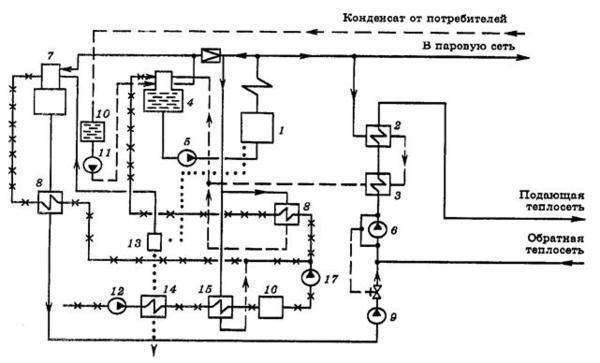
And in order to be able to increase the temperature to the desired values, a recirculation pump is installed. Water boilers must be monitored so that their service life is decent, control the constancy of water consumption. Usually the manufacturer sets the minimum data for this indicator.
For boiler rooms to work well, you need to use vacuum deaerators. Typically, a water jet ejector will create a vacuum, and the released steam is used for deaeration. But, the main thing that they are afraid of when installing a boiler room is the constant binding to the place. Modern automation simplifies many processes.
Features of connecting pumping equipment
If a forced circulation system is used to service the house, then when the power supply is cut off, the pump for the boiler must continue to work, receiving energy from a spare source. In this regard, it is best to equip the heating system with a UPS, which will support the operation of the structure for several more hours. External batteries connected to it will help to extend the life of the backup source.
When connecting the pump, avoid the possibility of condensation and moisture getting into the terminals. If the coolant heats up to more than 90 ° C, then a heat-resistant cable is used for connection. You will also need to avoid touching the walls of the pipes and the power cable with the motor and the pump casing. The power cable is connected to the terminal box on the right or left side with a change in the location of the plug. In the case of a lateral terminal box, the cable must only be run from the bottom side. A prerequisite is that the pump must be grounded.
Network pumps are often used to operate in boiler rooms. Such products perform the function of pumping hot water in a heating network system. The temperature of the network water, which the installed unit is able to drive through the pipes, reaches +180 degrees.
At the same time, the device and design of network pumps is relatively simple, and at the same time, the devices show a high level of performance along with reliability.
Boiler feed pump device device
Each pump for a heating boiler performs its own tasks in a closed-loop heating system. The main element of such a pump is the rotor, on which the efficiency of the unit directly depends. When the pump is running, the rotor rotates inside the stator, which is fixedly mounted on a solid base. Some models are equipped with a ceramic stator, which protects the rotor from limestone penetration.
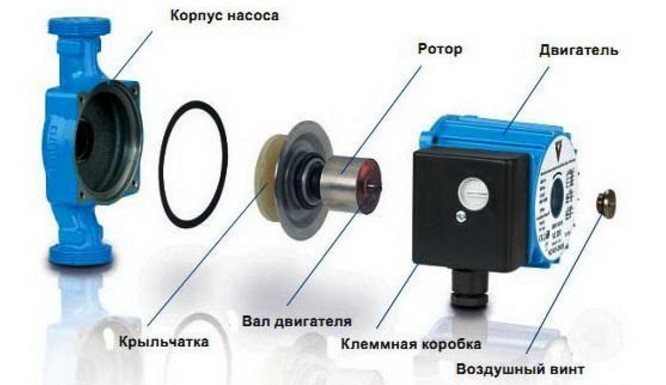

The edges of the rotor are equipped with blades, the rotation of which pushes the coolant further along the pipes. Most of the pumps for boilers are equipped with one rotor, but there are models with several working elements. The rotor is driven by an electric motor. The motors of most pump models are characterized by high power and long service life. All pump elements are housed in a robust aluminum or stainless steel housing.
Advantages of heating boilers with a pump
The heating water pump connection diagram allows you to equip the system with temperature controllers.If you install such devices near each radiator, you can control the heating of the coolant in the heating circuit and the room as a whole. Moreover, thanks to the use of temperature regulators, fuel savings are achieved, since the coolant does not heat up to maximum values.
Another advantage of using a circulation pump in heating is that the constant movement of the coolant does not allow pipes and batteries to cool down quickly if the boiler is temporarily turned off, so that comfortable conditions in the rooms remain longer.
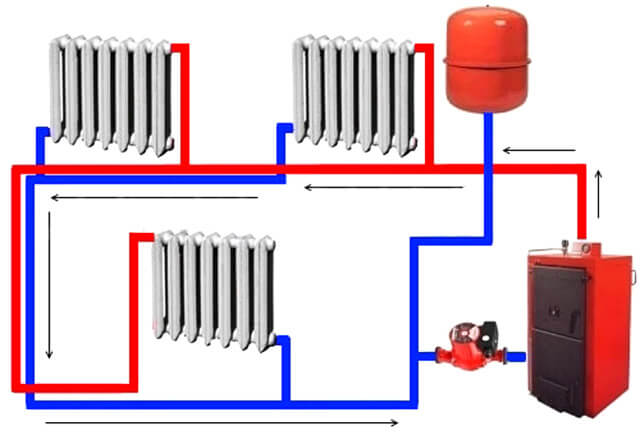

It is also important that a system with a pump does not need a large amount of coolant - it is needed much less than for heating with a natural type of liquid circulation.
Sometimes circulating pumps have additional functions. Some pump models pump the coolant through pipes every day, even in summer, so that the system retains functionality and does not stagnate. However, in some cases it may be necessary to install another pump with other functions, for example, to pump water into the system if it is drained in the summer.
With regard to air heat pumps, this is a slightly different type of equipment used in modern heating systems.
Boiler pump installation rules
Any equipment, be it a unit for a heating system, or a pump for flushing boilers, must be installed strictly in accordance with the manufacturer's recommendations. One of the most important conditions is choosing the right location for the device. The pump shaft must be perfectly horizontal. Otherwise, air locks will form inside the system, due to which the bearings and other elements of the unit will remain without lubrication. This will result in rapid wear of the device parts.
Another important condition is the correct choice of the place for the pump tapping. The unit must force the liquid to move through the pipeline
The standard installation diagram of the device is shown in the image below.
The main elements in the diagram are shown in this order:
- boiler;
- sleeve connection;
- valves;
- alarm system;
- pump;
- filter;
- membrane type tank;
- heating radiators;
- liquid make-up line;
- Control block;
- temperature sensor;
- emergency sensor;
- grounding.
This scheme ensures the most efficient operation of the pump and heating system. At the same time, the consumption of electricity by each individual element of the system is minimized.
Classification
All pumps are divided into two types:
Dry rotor pump
The working part of the rotor does not have direct contact with water due to the protection of several sealing wheels. These parts are made of carbon agglomerate, high-quality steel or ceramics, aluminum oxide - it all depends on the type of coolant used.
The device is launched due to the movement of the rings in relation to each other. The surfaces of the parts are perfectly polished, in contact with each other, they create a thin layer of water film. As a result, a sealing joint is created. With the help of springs, the rings are pressed against each other, due to which, as they wear out, the parts are independently adjusted to each other.
The service life of the rings is approximately three years, which is much longer than the life of the stuffing box packing, which requires periodic lubrication and cooling. The coefficient of efficiency is 80 percent. The main distinguishing feature of the unit's operation is a high noise level, as a result of which a separate room is required for its installation.
Glandless pump
The working part of the rotor - the impeller - is immersed in the coolant, which simultaneously acts as both a lubricant and an engine cooler.The electrical part of the motor is protected from moisture by means of a sealed stainless steel cup installed between the stator and the rotor.
Typically for the production of a rotor used ceramics
, for bearings - graphite or ceramics, for the body - cast iron, brass or bronze. The main feature of the unit is a low noise level, a long period of use without maintenance, easy and simple adjustments and repairs.
The coefficient of efficiency is 50 percent. This is because the sealing of the metal sleeve that separates the heat carrier and the stator is not possible if the rotor diameter is large. However, for domestic needs, where the circulation of the coolant is ensured in short pipelines, it is advisable to use such circulation pumps.
As part of a modular design
modern "wet" type devices include:
- Housing;
- Electric motor with stator;
- Box with terminal blocks;
- Working wheel;
- Cartridge consisting of a shaft with bearings and a rotor.
Modular assembly is convenient because at any time it is possible to replace a failed part of the circulation pump with a new part, and accumulated air is easily eliminated from the cartridge.
Boiler (heating) pumps: feed, circulating - connection
The boiler pump is used to improve the efficiency of heating systems. The device cuts directly into the heating circuit and increases the circulation of the liquid inside the pipes. This leads to a more even heating of each section of the heating line. Such an electric pump makes heating more efficient while consuming less fuel.
The main point is the correct selection of the type and model of the device for the characteristics of the boiler and pipeline. After all, the discrepancy between the purchased device and the system parameters excludes the positive effect of the device and can lead to breakdown.
The main types of pumps for the boiler
Depending on the scope of application of pumping devices, several types of devices are distinguished, which differ in terms of design solutions and parameters. According to the most obvious signs, boiler pumps are divided into 2 types:
- Circulation devices for a gas boiler.
- Boiler feed pumps.
Circulation pumping devices
The circulation pump is mounted on any section of the heating line. The device is represented by a metal case, inside which there is a rotor with an impeller. The rotor is driven by an electric motor connected directly to the control system (in some models, simply "on-off"). Alloys based on aluminum, steel, cast iron and bronze are used as the main material for the body of circulation models. The working part of the device is usually made of ceramic.
The device of the circulation pump with a wet rotor
During the operation of such pumps for gas boilers, the motor begins to rotate the rotor of the device through the shaft. The rotor impeller captures liquid particles and propels them inside the circular housing using centrifugal force. In this case, a low pressure is formed at the inlet to the apparatus, due to which liquid is sucked from the pipeline. When the water gains sufficient acceleration, a high pressure zone forms at the outlet and the liquid is pushed into the next section of the pipe.
Circulation devices in terms of design features are divided into two more types:
- dry rotor pumps;
- devices with a "wet" rotor.
In devices of the first type, the rotor is separated from the working fluid by a series of O-rings and glands, which ensure high tightness. Such a mechanism provides an efficiency of 80% from pump operation.
But, along with a clear advantage, there are also negative aspects of the operation of the device with a dry rotor.Firstly, the seals used are changed every 3 years, as they wear out too quickly. If the device is used for pumping liquids with a high content of impurities, the seals will wear even more. Secondly, the high noise level excludes the use of such models in living rooms. According to the type of execution, devices with a dry rotor are divided into:
- cantilever, in which the engine and diffuser are placed perpendicularly and connected by an adapter;
- block options are a monolithic housing, inside which both the engine and the rotor are located;
- vertical devices cut into the pipe, while the engine is located vertically above the working chamber.
Dry rotor circulation pump device
Devices with a "wet" rotor differ in efficiency with an indicator of 50%. The power of such devices is sufficient for a domestic heating circuit, or they are used as an additional pump. The design of the apparatus assumes direct contact between the pumped liquid and the rotor. In this case, water from the pipeline plays the role of natural lubrication, which prevents wear of parts.
Glandless rotor models have a long service life as no glands or seals are used. In addition, during operation, such devices actually do not emit noise, which allows them to be installed in residential premises. Modes of operation of the pump with a "wet" rotor can be switched during operation without shutting down the device.
The brands Grundfoss, Wilo, Dzhileks, Navien are popular among the variety of circulation pumping equipment.
A popular option for equipment from the Grundfoss and Wilo companies are Wilant pumps. The inscription on the body of the device means that the pump model was originally designed for the Vaillant boiler. The device has a capacity of 85 watts. All models are equipped with two or three modes of operation.
In the line of models of the Grundfos brand, UPS 25-50 180 is in demand. The device's capacity is 3.3 cubic meters. m / h. The head is supported up to 5 m. In this case, the device can operate in three modes.
As for the products of the Dzhileks company, a whole series of "Compasses" is assigned to the circulation options. An example of devices in this series is the device Compass 25/60. The device provides liquid supply at a distance of 6 m. One unit is enough to provide heating in a two-story house.
A separate segment of the production of world brands is the development of circulation devices for the parameters of a particular brand of boilers. The most common are models for the Baxi, Zota, Ariston boiler, as well as for the Navien gas boiler.
A boiler with a Zota pump is a separate segment of heating technology. Zota boilers are already equipped with a booster pump as standard, and are also designed to support two additional devices. In terms of automation, automatic and semi-automatic versions are distinguished.
Feeding units
Feed pumps are industrial installations designed to supply liquid to steam boilers of oil production enterprises and power plants. The temperature range of the liquid pumped by the feed pump for the steam boiler is 80-165 degrees. In this case, the important point is the percentage of impurities in the liquid. As a rule, the content of mechanical impurities in water for such devices should not exceed 0.2%.
Boiler feed pump
Depending on the principle of operation, feeding devices are divided into several types:
- centrifugal vortex devices;
- rotor-plate models;
- two-piston options.
Centrifugal vortex options are used to transport liquids with temperatures up to 105 degrees. The sphere of use of such devices is powerful drum-type boilers. In terms of design, such models consist of two impellers mounted on one shaft.The first centrifugal impeller is responsible for the suction of liquid from the supply line. The second wheel is a vortex working body. Its main task is to pump liquid into the outlet pipe.
Rotary-plate models are less sensitive to mechanical impurities than the previous type of apparatus, but are designed for steam boilers with low power. The working body of devices of this type consists of a rotor with an impeller, along the edge of which plates on springs are located. As the rotor rotates, the plates extend and push the water out into the discharge line. The advantage of this type is the small size of the models, which allows them to be neatly installed in the general interior of the production facility.
The two-piston unit includes two hydraulic cylinders and a suction and delivery valve block. The use of two cylinders with opposite cycles of operation allows for a snatch-free supply of fluid. Like the previous type, two-cylinder units work with small boilers.
Feed pumps are used not only for water, but also for chemical neutral solutions and substances. The working part of such devices is made of alloys of cast iron, steel or non-ferrous metals. Lip and face seals are responsible for the tightness of the engine compartment.
How to install a boiler pump in the system?
Connecting the pump to the heating circuit is an individual process for each individual model. But there are also common points here. When it comes to circulating devices, here, first of all, a pump is selected with threaded connections at the ends of the nozzles. This will simplify the installation process. Examples of such models are the lines Navien, Jileks or Grundfos. Such devices are designed for any boiler, including a two-circuit wall-mounted version.
Circulation pump installation procedure
The connection diagram for circulation options should take into account the following points:
- the most suitable place for tapping the device is the section of the supply pipe, near the junction with the expansion tank;
- it is advisable to install the pump on the bypass (additional) circuit, and the outlets to the main line should be equipped with valves for emergency situations;
- the location of the unit must be in an accessible place, in case the pump needs to be repaired or replaced;
- on the supply pipe, before entering the bypass working chamber, it is necessary to install a filter element that will retain mechanical impurities;
- versions with a "wet" rotor are installed exclusively in a horizontal position; dry - installed both vertically and horizontally;
- all threaded connections are carefully sealed with a sealant.
As for the answer to the question "How to connect the feed pump?", There are also several main points. The main condition for the installation site of the unit is the absence of liquid cavitation inside the pipeline before entering the device. As a rule, for this, it is installed at the lowest point of the building, and the connected pipeline should be as short as possible and without bends.
It is advisable to install a check valve on the discharge pipe, which prevents the return of water from the pipeline. As for the selection of the correct model, here the choice is based on calculations for each individual system and type of apparatus. Such calculations are carried out by a specialist.
CONNECTING THE CIRCULATION PUMP TO THE BOILER (VIDEO)
Home page »Pumps
byreniepro.ru
Grundfos make-up pumps develop a sufficiently high pressure
How do I get a discount?
Click "I like"
Print coupon
Get a discount!
- Click the "Like" button on any of the social networks provided.
- In the pop-up window that appears, click the “print coupon” button. A discount coupon will appear in front of you.
- Print out a coupon that entitles you to a 5% to 20% discount on goods and services of our company!
Grundfos Authorized Service Partner
Service
warranty and post-warranty
at objects of any complexity
Commissioning
Pumping technology has evolved quite strongly since its introduction into the national economy. At the moment, such devices are often equipped with all kinds of automation. Starting from protection against dry running, mechanical check valves that exclude the return flow of the pumped substance and ending with powerful electronic units that allow you to regulate the rotation speed by changing the frequency of the electric current, measure various characteristics in real time: temperature, current, flow rate, and the like. ...
These processes did not pass by the Grundfos pumps for feeding the heating system and the boiler. These state-of-the-art devices combine excellent quality with the latest advances in science and technology. Despite, at first glance, an auxiliary function, these devices are capable of creating a sufficiently high pressure, which makes it possible to use them even during the initial filling of the system, or during the planned replacement of the coolant.
And for a more detailed acquaintance with the assortment, you can refer to the Grundfos feed pumps catalog, located on the website of the manufacturer's official representative in our country.
Installation of a chiller and air conditioning system in the building of the shopping center on the Kashirskoye highway in Moscow
The employees of the United Service Center CJSC carried out the installation of the chiller and related equipment in the building of the shopping center on the Kashirsky Highway.
Where to buy “Grundfos Booster Pumps”?
Shipment of the goods "Booster pumps Grundfos"
- self-pickup at the address Moscow, 127282, Polyarnaya street, house 31A, building 1. (show the map)
In other cities
Shipping costs in these cities depend on the availability of the goods in the local warehouse. The current availability can be checked by calling our office in your city:
We will be able to offer you the lowest price and shortest delivery times, in comparison with competitors in your region.
The role of Grundfos booster pumps in the heating system
For heating systems, the role of pumping technology is especially important. Firstly, many modern systems require forced circulation of the coolant in the circuit, and secondly, from time to time, the system requires replenishing the volume of the heat-carrying fluid. It is possible to create an absolutely sealed circuit, but this will not become a panacea, because after a certain period of time, a partial or complete replacement of the coolant is required, depending on the technical conditions of the heating system. Also, do not forget about routine maintenance, in which the radiators and the circuit as a whole are flushed, which implies a depressurization of the heating circuit. Therefore, regardless of the geographical location of the owner of the heating system (for example, in Lyubertsy), the Grundfos feed pump will come in handy.
What are the make-up pumping units for?
The answer to this question covers many areas of industrial and domestic applications. We are talking about air conditioning, heating, ventilation and other engineering structures. And the introduction into various auxiliary and main production processes allows the use of Grundfos make-up pumps even for aggressive media and liquids. This will ensure the non-stop operation of the production line, for example, the CIP-washing, which is an essential element in the food industry.
The various design of the units allows them to be used under any environmental conditions: in a living room, in a workshop, in a boiler room, in the open air. After all, the manufacturer has taken care of all possible ways to use this type of equipment. And even a street pump Grundfos has been developed, which is relevant in Korolev and Mytishche.
Now you only need to carefully select the model of the required make-up pump, based on the technical conditions of your system.
Application of frequency converters for booster pumps
Make-up pumping units are used to maintain the hydrostatic mode of the return line of the heating network. The pumps operate with variable load, the use of frequency converters improves reliability, synchronizes performance with actual needs. Frequency converters:
- Adjust the head according to the actual load.
- Provide shutdown of units in case of emergencies, automatic activation and deactivation of standby pumps.
- They transfer data on operating characteristics and modes to the dispatching console and the control controller.
The use of a control scheme based on frequency converters eliminates the need for a control valve.
Monoblock pump
Previously, pumping units mounted on a foundation or frame, consisting of a pump and a drive, were used as network pumps. Mechanical energy was transferred from the drive to the pump through a group of drive mechanisms. This was primarily due to the need to use powerful drives.
- The modern range of pumping equipment allows the use of monoblock pumps as network pumps.
- The use of monoblock pumps allows, first of all, to significantly save installation space.
- This is especially true when using monoblock pumps with a vertically positioned shaft.
- The use of modern pumping equipment in the modernization of existing boiler houses makes it possible to reduce the required installation area by two or more times.
Buy network monoblock pump from Interpamps
LLC "Interpamps" offers reliable pumping equipment of the Etaline and Etaline-R series, with a capacity of up to 2000 cubic meters per hour, and a pressure of up to 100 meters of water column, designed for operating pressure up to 25 bar and temperatures from -30 to +140 degrees Celsius ... Due to their design and operating parameters, Etaline pumps can be used as network pumps, both in stationary boiler houses and in block-modular ones. Coaxial fittings in Etaline pumps greatly simplify pump piping. Allowing, among other things, to install Etaline pumps directly into the existing pipeline without changing the latter. High efficiency and reliable design of the pumps can significantly reduce the cost of subsequent operation.
The central office of Interpamps LLC is located in Moscow, we offer our partners to buy high-quality pumping equipment inexpensively. We make the selection of pumping equipment at the request of our partners free of charge and in the shortest possible time.
The circulation pump for the boiler of the heating system performs a rather important function - it is he who is responsible for the uninterrupted circulation of the coolant through the pipes and radiators. The choice of the unit largely determines the efficiency of the heating system and the comfort of living in a private house or apartment.
Selection of a make-up pump for a boiler room
The charge pump must develop a high pressure higher than in the heating circuit with a relatively small flow. Still, for replenishment, pumping of large volumes of liquid is not required. The selection of such a pump is carried out according to several requirements.
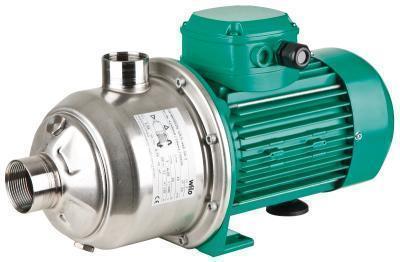

Selection of the make-up pump:
- It must create a pressure that will exceed the pressure in the CO return line;
- Also, the pressure should be able to push through the hydraulic resistance of the pressure sensor, pipeline;
- Another important criterion is the flow rate, in particular, for closed COs, the leak rate is half a percent of the volume of the coolant in the boiler and heating circuit.
At the same time, I would like to say that it is not very practical to purchase such a pump for work. In the sense that it should not only serve to recharge. It can also perform additional functions, for example, be a backup circulation pump, and also be used to pump and drain water into the circuit.
How to choose the right circulation pump for the heating system, read the article:.
Monoblock pump
Previously, pumping units mounted on a foundation or frame, consisting of a pump and a drive, were used as network pumps. Mechanical energy was transferred from the drive to the pump through a group of drive mechanisms. This was primarily due to the need to use powerful drives.
- The modern range of pumping equipment allows the use of monoblock pumps as network pumps.
- The use of monoblock pumps allows, first of all, to significantly save installation space.
- This is especially true when using monoblock pumps with a vertically positioned shaft.
- The use of modern pumping equipment in the modernization of existing boiler houses makes it possible to reduce the required installation area by two or more times.
Buy network monoblock pump from Interpamps
LLC "Interpamps" offers reliable pumping equipment of the Etaline and Etaline-R series, with a capacity of up to 2000 cubic meters per hour, and a pressure of up to 100 meters of water column, designed for operating pressure up to 25 bar and temperatures from -30 to +140 degrees Celsius ... Due to their design and operating parameters, Etaline pumps can be used as network pumps, both in stationary boiler houses and in block-modular ones. Coaxial fittings in Etaline pumps greatly simplify pump piping. Allowing, among other things, to install Etaline pumps directly into the existing pipeline without changing the latter. High efficiency and reliable design of the pumps can significantly reduce the cost of subsequent operation.
The central office of Interpamps LLC is located in Moscow, we offer our partners to buy high-quality pumping equipment inexpensively. We make the selection of pumping equipment at the request of our partners free of charge and in the shortest possible time.
If the boiler room is designed correctly, then it will serve both heating systems, and ventilation, and the supply of hot and cold water. One might say that no one designs communications on their own. They are guided by at least a typical plan. His choice depends on the type of premises for which it is provided.
The graphic drawing should reflect all mechanisms, apparatus, devices, as well as the pipes connecting them. In standard boiler room schemes, both boilers and pumps (circulation, make-up, recirculation, network), and storage and condensation tanks are included. Also provided are devices for supplying fuel, burning it, as well as devices for deaerating water, heat exchangers, the same fans, heat shields, control panels.
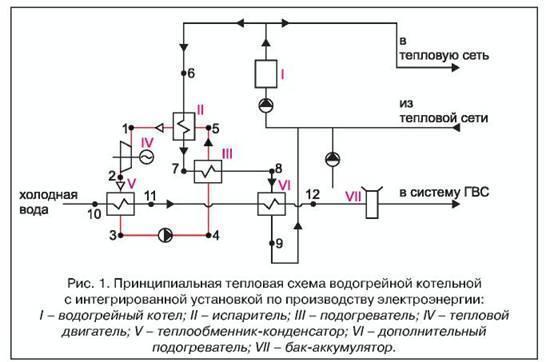

Those heating networks that operate on water are divided into two groups:
- Open (in this case, the liquid is taken in local installations);
- Closed (water returns to the boiler, giving off heat).
The most popular example of a schematic diagram is an example of an open-type hot water boiler house. The principle is that a circular pump is installed on the return line, it is responsible for delivering water to the boiler, and then throughout the entire system. The supply and return lines will be connected by two types of jumpers - bypass and recirculation.
The technological scheme can be taken from any reliable sources, but it would be good to discuss it with specialists. He will advise you, tell you whether it is suitable in your situation, explain the entire system of action
In any case, this is the most important structure for a private house, therefore attention should be maximized
Advantages of frequency converters for boiler pumps
Application of electric drives based on frequency converters for pumps:
- Reduces operating costs. Savings are achieved by reducing wear on pumps and electric motors, reducing the number of accidents and water hammer.
- Saves energy. Frequency converters regulate the performance and head of the pumps depending on the actual needs. Their use makes it possible to abandon schemes with valves and throttles. The use of frequency converters reduces power consumption by 20-50%.
Frequency converters also reduce the noise level in the machine room, simplify the hardware implementation of the protection and automation of pumping units, and also significantly reduce the load on the electrical network. The effectiveness of the modernization of the electric drive depends on the specifics of the boiler room. According to standard technical and economic calculations, the average payback period for frequency converters for boiler houses is 1.5-2 years.
What you need to know about it
First of all, it is advisable to study the design of the heating system, to understand the essence of its work. To begin with, heating begins with boiler rooms, where some kind of fuel (gas, coal, firewood) is burned, and then heat is transferred through pipes through a coolant. Heat carriers are of several types: air, steam, and the most common is water. But water tends to freeze at low temperatures. Therefore, where necessary, antifreeze diluted with water is used in order to reduce the negative destructive effect on the pipeline. A calculation is performed to help determine the correct ratio of water to antifreeze. With central heating, the coolant can be directed through a pumping system or through a conventional one.
The usual, or natural, system is very simple: the water heated in the boiler moves through one pipes, warming up the radiators, and then returns through others to heat up again. There is also an expansion tank and air vents in this simple device. The latter are needed in order to eliminate air bubbles and various gases that can accumulate in the pipes. And excess moisture leaves the expansion tank, which appears when the water expands from heating.
A closed heating system is characterized by a pump. It helps to accelerate the water more than it moves in a conventional pumpless system. A pump is especially needed if the pipes are too narrow, and this interferes with the circulation of the coolant.
What pumps are used for boiler rooms
Network pumps for boiler rooms are most often centrifugal, equipped with an electric motor. By type, they can be divided into: condensate, network, make-up, intended for raw water. You can also find this type of pump as a feed pump.
In boiler water supply systems, it is customary to install several devices at once that have the same characteristics. The pumps are connected in parallel, with one of them being the main one, and the second being the backup one and starts up as needed when the first one fails. However, it is also possible to operate two devices at once. In this case, the water pressure in the pipes remains the same as during the operation of one unit, but the water supply increases, the level of which becomes equal to the sum of the supply of each of the devices.
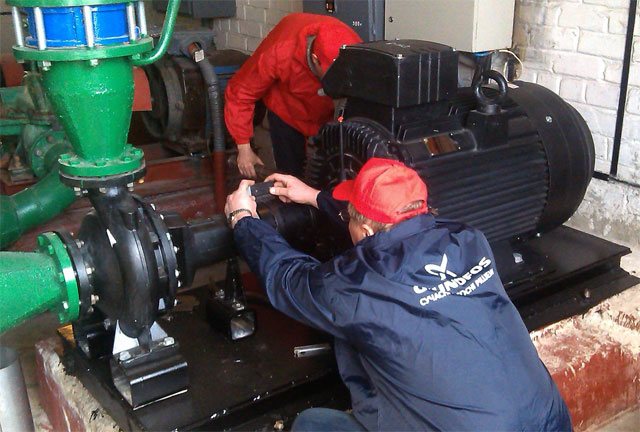

Boiler room pumps can have enormous weight and dimensions.
For boiler houses, the most optimal option would be to install a centrifugal 1-stage pump of the KM type, a 1-stage unit of the D type with 2-sided suction, or a multistage product of the CNSG type. In addition, many professionals recommend installing condensate type KS in a boiler plant. In this case, the final choice depends on the specific requirements of the buyer, which, as a rule, are determined by the operating conditions of the future equipment.
Selection of the device and calculation of the required pressure
Pumps for boiler rooms are selected strictly based on the requirements of the heating system, or rather, on the required pressure. To understand how much head is required for optimal performance of your system, you can refer to the formula created for this purpose.
At first glance, the formula does not look very simple, but when studying each value, it will not be difficult to calculate the required pressure. The symbols in the formula, which can be used to calculate the required pressure, mean:
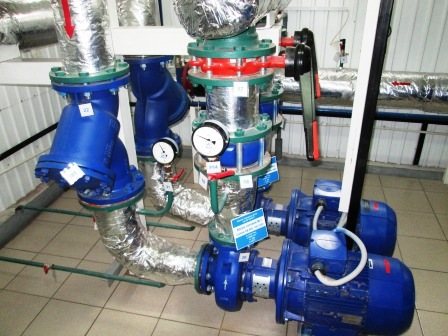

Along with the pumps, manometers, taps, filters are installed
- H is the required head pressure in meters of the water column;
- Ltot is the total length of the circuits, taking into account the return and supply pipes. If you use a warm floor, you need to take into account the length of the pipes laid under the floor in the calculation;
- Rsp is the specific resistance level of the pipes of the system. Taking into account the stock, take 150 Pa per 1 running meter;
- r is the total value of the resistance of the pipeline system;
- Pt is the specific density of the heat carrier;
- G is a constant equal to 9.8 meters per square centimeter, or the unit of acceleration due to gravity.
Often there is a difficulty in calculating the total resistance of system elements. However, in this case, the general formula can be simplified by replacing the coefficient k, which is a correction factor, instead of this sum. So, the correction factor of the system in which any thermostats are installed will be 1.7.
For a conventional system with standard fittings and valves without thermostatic control elements, the correction factor is 1.3. The system, which has many branches and valves with high saturation, has this coefficient at the level of 2.2. The calculation according to the final formula, in the case of a correction factor, will look like this: H = (Lsum * Rsp * k) / (Pt * g).
Having made a calculation using this formula, you can understand what parameters and characteristics the pump that you need to purchase owns. We emphasize that it is recommended to choose a pump for boiler rooms, the power of which will not exceed the necessary pressure to create the necessary pressure. By purchasing a pump with a power exceeding the required power to provide the desired head, you will simply be wasting money.
feed pump for steam boilers, technical requirements
The article is a technical assignment for a feed pump for a CCGT-35 thermal station, the TOR was drawn up by a very serious design institute.
Feed pump
1 General
The terms of reference were drawn up for the object "Creation of a CCGT-35 unit, with the installation of a GTU-25, a waste heat boiler and a steam turbine." The project provides for the installation of three feed pumps in the main building.
This technical assignment is preliminary (for selecting a supplier), technical requirements and characteristics will be clarified after determining the supplier of the main equipment and providing the technical characteristics of the main equipment.
2 Technical requirements for the selection of equipment
2.1 General requirements
Electric feed pump units (hereinafter PEN) are designed to power the existing steam boiler unit BKZ-50-39f st. No. 2 with a steam capacity of 75 t / h and a designed waste heat boiler with a steam capacity of 40 t / h, operating on a common steam header with a superheated steam pressure of 4.0 MPa (abs). The waste heat boiler is designed to operate as part of a 35 MW combined cycle gas turbine unit.
The units are installed in a category "D" room. Climatic version -UHL -4.
The pumps pump water with temperatures up to 110 ° C.
The quality of the feed water must comply with the following requirements (by analogy with STO 70238424.27.100.013-2009 INVEL RF for waste heat boilers of TPPs with CCGT power units) and is indicated in table 1.table 1
| Controlled indicator | Dimension | Water-chemical regime |
| ACP | ||
| pH | 8,9 – 9,2 | |
| æн - electrical conductivity of the H-cationized sample | μS / cm | ≤ 0,5 |
| æ - specific electrical conductivity | μS / cm | — |
| Nh4 - ammonia | μg / dm3 | — |
| О2 - oxygen content behind the deaerator | μg / dm3 | ≤ 10,0 |
| SiO2 - silicic acid content | μg / dm3 | ≤ 10,0 |
| Fe - total iron | μg / dm3 | ≤ 10,0 |
| Na - sodium | μg / dm3 | ≤ 5,0 |
| TOC - total organic carbon | μg / dm3 | — |
| End of table 1 | ||
| Controlled indicator | Dimension | Water-chemical regime |
| ACP | ||
| Content of petroleum products | mg / dm3 | ≤ 0,1 |
| Chlorides | μg / dm3 | ≤ 3,0 |
[reklama2] The equivalent sound pressure level during operation of the unit should not exceed 80 dBA in a free field at a distance (horizontal) of 1 m from the base of the equipment at 1.2 m above the floor level. The start time of the PEN from the reserve state should be no more than 10 sec.
2.2 Requirements for pump motors
The existing steam boiler unit BKZ-50-39f st. No. 2 with a steam capacity of 75 t / h and the designed waste heat boiler with a steam capacity of 40 t / h, operating on a common steam header of 4.0 MPa (abs.), Are equipped with three feed pumps (2-working, 1-standby). The electric motor of one working pump is equipped with a variable frequency drive. In the nominal operating mode of the boilers, two pumps are in operation and one is in standby.
When operating electric motors, their control gears and protections, their reliable operation must be ensured in all operating modes and during start-up.
The motor must be able to operate at a voltage of 90-110% of the nominal voltage while maintaining their nominal power.
The rated power of electric motors must be maintained with a simultaneous voltage deviation of up to ± 10% and a frequency of up to ± 2.5% of the nominal values, provided that when operating with increased voltage and reduced frequency or with reduced voltage and increased frequency, the sum of the absolute values of the voltage and frequency deviations is not exceeds 10%.
The engine cooling system is air, without cooling water supply.
2.3 Requirements for the lubrication and cooling system
The pump lubrication system is autonomous for each pump, without external oil coolers, oil type TP-22S or similar.
As cooling water for seals, heat exchangers of end seals, chemically demineralized water with parameters P = 0.4 MPa t = 33 C is used.
Oil must not get into the cooling water.
2.4 Equipment design requirements
The maintainability of the pump must be ensured.
The marking, packaging and preservation of the pump must comply with the current standards of the Republic of Belarus.
The design of the pump must allow the use of an amine-containing water-chemical regime.
The electric pump unit must comply with the requirements of the "Rules for the construction and safe operation of steam and hot water pipelines".
The pump nozzles must accept loads from the connecting pipelines of at least 400 kgf in any direction.
The pump must be designed to prevent oil from entering the cooling water.
2.5 Reliability indicators
Mean time between failures - at least 7000 hours (for bearings at least 40,000 operating hours).
The service life between major overhauls is 8 years, but not less than 40,000 hours.
Unit availability factor -0.98 (not less)
Service life - 40 years.
3 Main parameters and characteristics
The operating range of flow rates is 10-60 m³ / h.
Nominal flow rate 50 m³ / h.
Head in the operating range of flow rates of 500-580 m water. Art.
Nominal head 550 m.
The cavitation reserve in the operating range of flow rates is not more than 6 m.
Automation and diagram of the boiler plant
Automation makes it possible to use a set of programs that control heat flows. It also depends on the regime of the day, on the weather. Including, this is also needed for heating additional rooms: a playroom, a swimming pool.
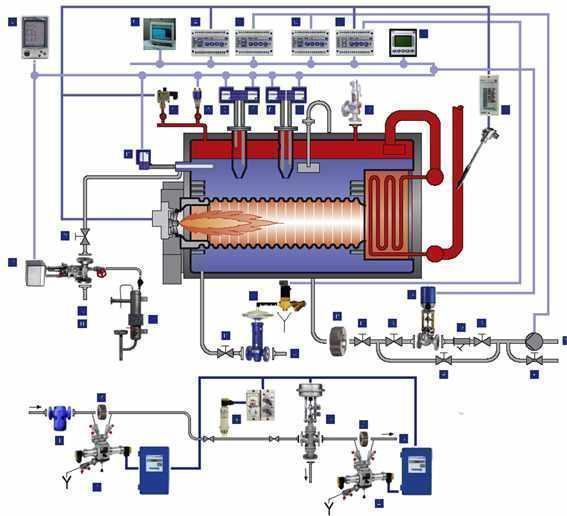

There are some popular custom functions that adapt the operation of the equipment with an eye to the lifestyle of the owners of the house. This is both an ordinary hot water supply system, and a set of some individual options that are convenient for these particular residents, and are economical.In the same way, you can develop a boiler room automation scheme by choosing one of the popular modes.

